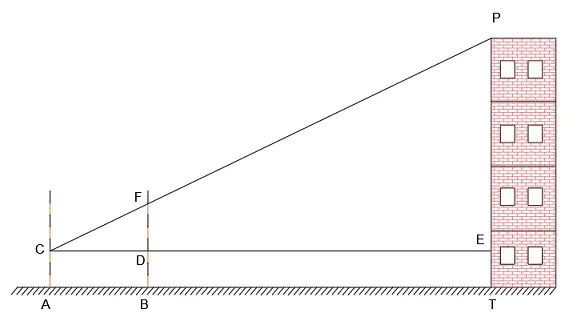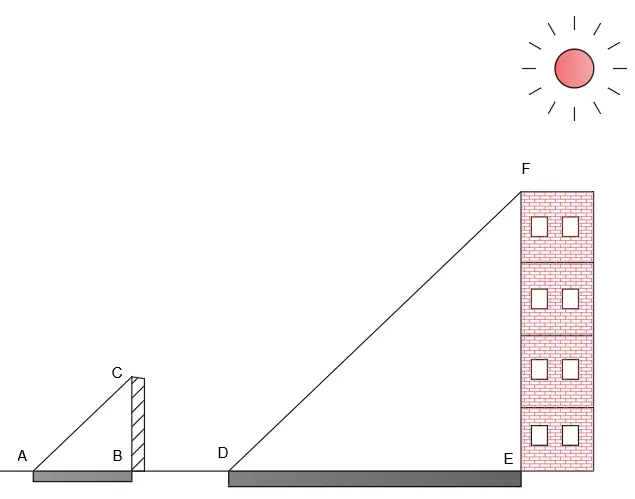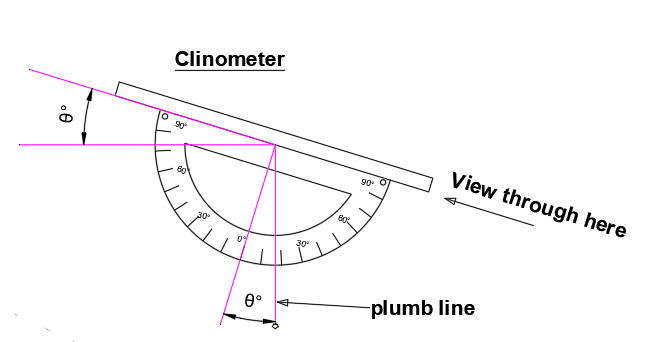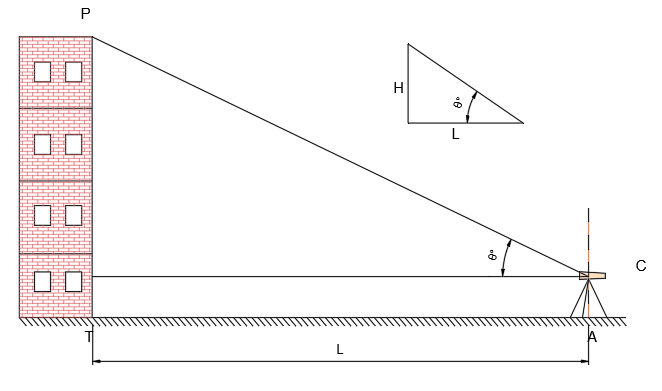Measuring the height of a building might seem like a complicated task, but with the right methods, it’s quite simple. Whether you’re an architect, engineer, or just a curious person wondering how tall that building is, there are ways to measure its height indirectly. In this article, we will discuss 4 easy ways to measure a building’s height using basic tools and techniques. From shadow measurement to using basic geometry, you can easily estimate a building’s height without needing advanced equipment.
Why Is It Important to Measure the Height of a Building?
Before diving into the methods, let’s first understand why measuring the height of a building might be important. There are several reasons why you might want to know the height:
- Construction and Design: Architects and engineers need accurate measurements for designing and constructing buildings.
- Safety Concerns: Knowing the height helps in planning safety measures for both workers and future inhabitants.
- Real Estate: Property buyers and investors often want to know the height for investment purposes.
Now that we understand the importance, let’s dive into the 4 ways to measure the height of a building indirectly.
How to measure the height of a building
We can measure the height of a building in various ways when it is not possible to measure the height directly. Thus to measure the height of a building or a tree various instruments are also used depending on different conditions. The methods for finding out the height of a building or a tree are as follows:
- Using only ranging rods and tape.
- Using the Shadow of the building or the tree.
- Using a clinometer.
- Using a transit theodolite.
Using only Ranging rods and Tape-
Conditions: This method is suitable when the ground is level.
Instruments required: Two ranging rods and Measuring tape.
Procedure: Let us assume the height of the building is PT, which is to be determined. T is the base and P is the peak of the building. Two ranging rods are fixed at A and B on level ground at some distance apart. On these ranging rods, C and D are marked in such a way that AC = BD.
Now point E is marked on the building by looking through the line CD. Next, point P is sighted from point C, while keeping points C, F, and P at a straight line. Then AT, AB, and DF are measured.
From ΔPEC and ΔFDC we can say,
PE/CE =DF/CD
or, PE= (FD/CD) x CE
i.e., PE = (FD/AB) x AT.
we can easily measure the ET with tape.
Height of the building = PE +ET.

Using the Shadow of the building or the tree
Conditions: This method is suitable when the ground is level.
Instruments required: One ranging rods and Measuring tape.
Procedure: Let us assume the height of the building is EF and the length of its shadow is DE. Now we put a ranging pole at some distance. The height of the ranging rod is BC and the length of its shadow is BC.
length AB, BC, and DE can be easily measured by tape.
So from Δ ABC and Δ DEF, we can say,
( BC/AB )=( EF / DE)
or, EF = ( BC / AB ) x DE = height of the building.

Using the Shadow of the building or the tree
Conditions: This method is suitable when the ground is at a slope.
Instruments required: One ranging rods and Clinometer.
Clinometer
A clinometer is an instrument used for measuring the angle of inclination. A clinometer is basically similar to a graduated semi-circular protector. There are two pins near the straight edge for sighting objects. A plumb bob is suspended from the center of the clinometer. The plumb line coincides with 0° when there is no slope( i.e., horizontal).
For measuring any slope, the clinometer is tilted, but the plumb line remains vertical. In this tilted condition, the plumb line coincides with a graduation on the clinometer. This graduation indicates the inclination of the object.

Procedure
A clinometer may be used to measure the height of a building or a tree. At first, a ranging rod is fixed at the point from where the angle is going to be measured. Now the surveyor measures the inclination of the top of the building. Let’s say the angle is Θ°. In the next step, the distance between the ranging rod is measured, say the distance is L.
So we can say, height = base x tanΘ° = LtanΘ°.
So the height of the building is TP = (LtanΘ°+ the height of the clinometer).

Using a transit theodolite.
Instruments required: One ranging rods and a transit theodolite
Theodolite.
A theodolite is a universal instrument in surveying. This instrument can measure various types of measurements. We can measure different types of horizontal and vertical angles with it. We can also measure distance with a theodolite when it is impossible to chaining. Basically, a theodolite can measure-
- horizontal angle
- vertical angle
- deflection angle
- magnetic bearing
- ranging and extending a line
- horizontal distance
- vertical height.
A theodolite is classified into two types:-
- transit theodolite
- non-transit theodolite
What is transiting and swinging?
The rotating of the telescope of a theodolite around a horizontal axis in a vertical plane is called transiting. The other terms of transitioning are reversing or plunging.
If a theodolite can transit then it is called transit theodolite.
The rotation of the telescope in a horizontal plane around a vertical axis is called swinging.
Procedure
To measure the height of a building with the help of a theodolite is as follows.
- Finding the vertical angle of the top of the building.
- Measuring the horizontal distance between theodolite and the building.
- calculating the vertical height of the building.
Finding the vertical angle of the top of the building.
- At first, the theodolite is set up by centering at the position from where the angle is to be measured.
- Then we have to level the theodolite with the foot screw and check the bubble tubes.
- Sight the object approximately. Then restrained the horizontal rotation of theodolite by locking lower and upper clamp screws.
- After that, adjust the zero of the vertical circle with the zero of the vertical vernier scale.
- Now bisect the top of the building by adjusting vertical clamp screw and tangent screws.
Measuring the horizontal distance between theodolite and the building
If the ground surface is a level surface, we can easily measure the distance with a chain or tape. But if the ground surface is steep with undulation, then we cannot measure with a chain or tape. In that case, we have to measure the distance with the help of a tacheometer.
A tacheometer is a transit theodolite fitted with an additional lens and a stadia diaphragm.
Calculating the vertical height of the building.

Let us assume that the angle measured by the surveyor with the theodolite is Θ°. The distance is L. So the height of the building above the line of sight is H= L x tanΘ°.
The total height of the building is the height of the instrument + LtanΘ°.
FAQs
1. How accurate are these methods?
The accuracy depends on the tools used and the method chosen. With a laser measure or smartphone app, you can get very accurate results. Trigonometry and shadow measurement methods are also reliable but may be less precise due to environmental factors.
2. Can you measure the height of a building without going near it?
Yes, using methods like shadow measurement, trigonometry, or laser devices, you can measure the height of a building from a distance.
3. What tools do I need to measure a building’s height indirectly?
You can use simple tools like a tape measure, protractor, or even your smartphone. For more accurate measurements, laser distance meters and specialized apps are also available.
4. How do you calculate the angle of elevation?
You can calculate the angle of elevation by using a protractor or a clinometer. Alternatively, some smartphone apps are designed to measure angles directly.
5. Can this method be used for tall skyscrapers?
Yes, these methods can work for tall buildings as long as you have the right tools. For skyscrapers, using a laser measure or smartphone app may be the best option.
6. How do I know if I’m standing the right distance away from the building for accuracy?
It’s important to stand far enough away to get a good angle. Ideally, you want the angle of elevation to be between 30° and 60° for accuracy.
7. Can these methods be used for buildings of any height?
Yes, these methods can be used for buildings of all heights, but some methods like using shadows may be more difficult with very tall structures.
8. How can I improve the accuracy of the measurements?
To improve accuracy, make sure your measurements are precise and use tools like a laser distance meter for better precision.
9. Is it better to use trigonometry or a smartphone app?
It depends on your preference and the tools you have. If you’re comfortable with trigonometry and have a protractor, you can get good results. For ease and convenience, a smartphone app is a great choice.
10. Are these methods safe?
Yes, these methods are safe, as long as you’re not standing in dangerous areas like near heavy traffic or construction zones.
Conclusion
In conclusion, measuring the height of a building doesn’t require complex equipment or advanced technology. With methods like shadow measurement, trigonometry, using reference objects, and modern tools like smartphone apps and laser meters, you can get a fairly accurate estimate. Depending on your situation and the tools at your disposal, choose the method that best suits your needs. Whether you’re an engineer, student, or just someone curious about the world around you, these techniques make it easier than ever to measure the height of a building indirectly.
Key Takeaways:
- Simple tools like protractors, tape measures, and reference objects can be used for indirect measurements.
- Trigonometry and shadow methods are useful for estimating building height without needing to be right next to it.
- Modern tools like smartphone apps and laser distance meters can provide accurate results in a short amount of time.
- The accuracy of your measurements depends on the tools used and the method selected.
Do you know that using a smartphone app or laser meter can be 10 times faster than traditional methods? It’s a quick and modern way to measure buildings accurately!
